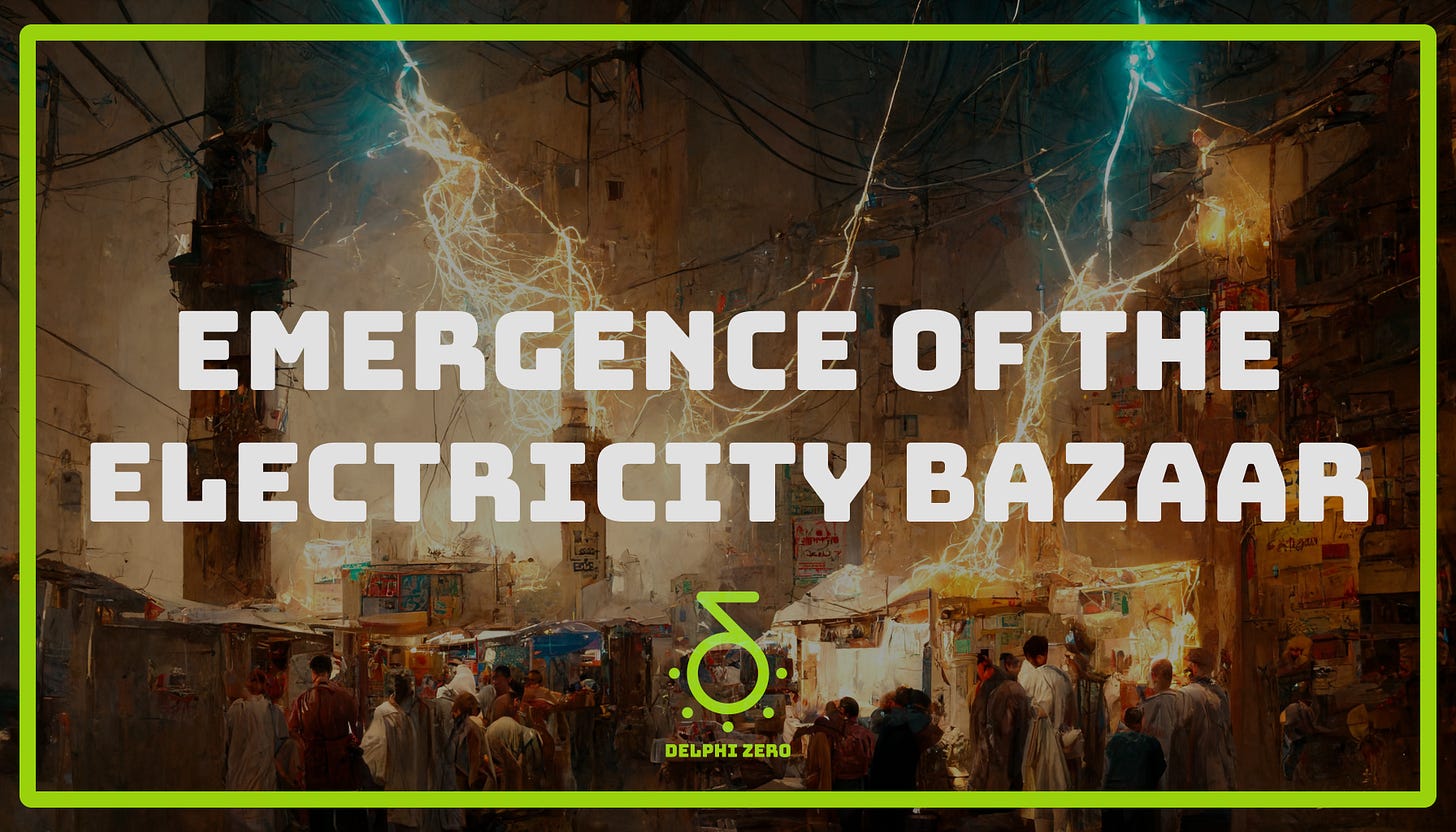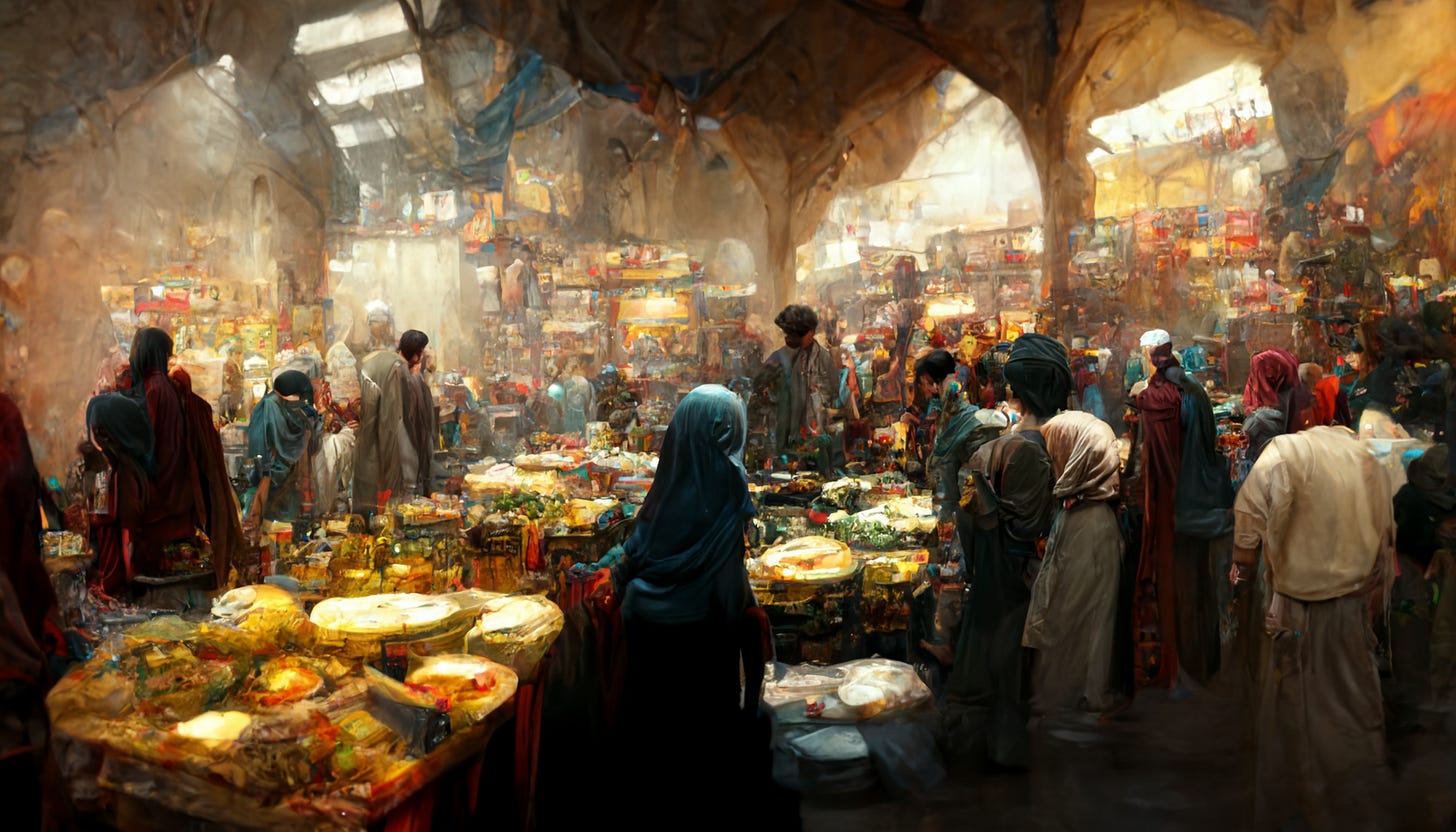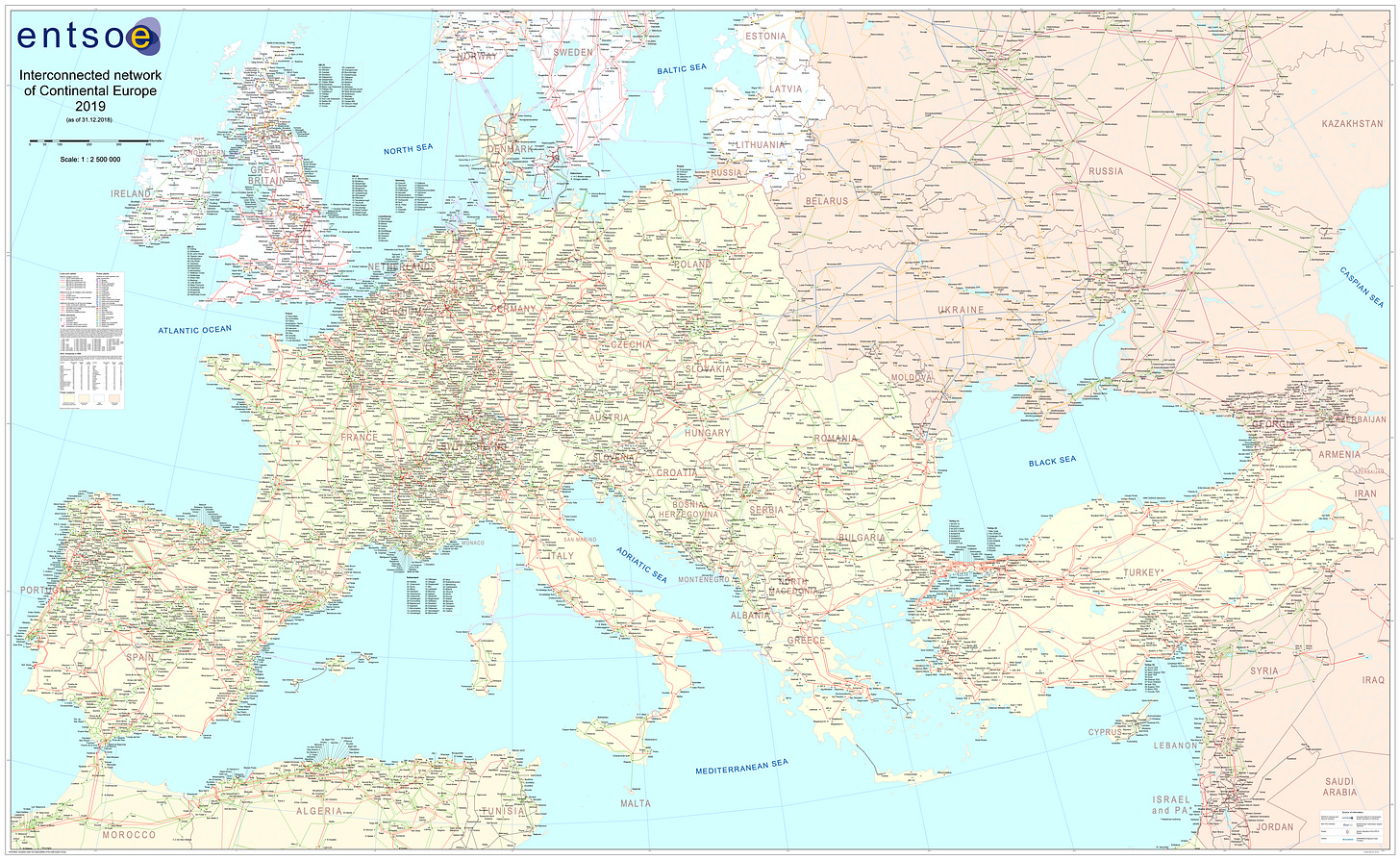Emergence of the Electricity Bazaar
From national monopolies to entrepreneurial wonderlands.
👋 Howdy to 42 new readers who joined recently! We are 525 climate buddies now 🌳
Ho ho ho and welcome to the last piece of the year 🎅
In my essay “Energy and War,” I shared that I’m currently studying Energy Law with a focus on the European Energy Union 🇪🇺 What an experience so far! Many of our instructors are flying in from Brussels to share insights from day-to-day EU policymaking. Truly fascinating stuff. Recently, we had Dr. Koch (Deputy Head of the Internal Market Unit of the Commission’s Energy Directorate-General) and Dr.-Ing Müller-Kirchenbauer in class to talk about the development of the Integrated European Energy Market.
These lectures reminded me of what I saw in the advertising market when I was building a startup together with my co-founders Erik, Spencer, and Mike. Back then, we capitalized on a unique insight that markets are becoming more efficient. We leaned into this arbitrage opportunity and built a successful company in the recruitment advertising market. The evolution of energy markets - and electricity markets in particular - are tickling my spider senses yet again 🕷
In this essay, I’ll share a brief history of energy markets in Europe and why the future holds massive entrepreneurial opportunities. All correct information is based on the insights shared by my instructors and other researchers/writers. All omissions and mistakes are my own.
To summarize: We are in the early innings of the energy market unbundling.
Lean back and enjoy the ride 🙌
Emergence of the Electricity Bazaar
By Art Lapinsch
Humanity has come a long way, yet we still conduct business like we did centuries ago.
Markets: The Fundamental Building Blocks of Economy
Think of a middle eastern bazaar where sellers (= supply) and buyers (= demand) meet to have more choice (= market/exchange).
The seller with the best product usually builds a reputation. Customers want the best deal, so they flock to the seller with the best product. The beauty of markets is that information travels fast. In the past, it was word of mouth. Today, it is digital signals. Customers react to the new information, and the market starts to balance itself. The moments during this rebalancing process open up arbitrage opportunities.
Hundreds of years later, we still trade on markets. What applies to spices and vegetables holds for stocks and other digital goods.
Bundling and Unbundling
“There are only two ways to make money in business: One is to bundle; the other is unbundle.” - Jim Barksdale
Markets have a balancing mechanism, and it’s called Bundling vs. Unbundling
Think of a tomato seller (A) at the bazaar. They sell tomatoes and notice that their buyers frequently ask for cheese. The tomato seller decides to trust his business instincts and starts offering cheese. When a seller starts offering multiple products/services at an improved price, it is called bundling. Customers like the convenience of buying both products from one seller, so the tomato/cheese seller starts to capture a larger share of all sales on the market.
[🍅 + 🧀] > [🍅 || 🧀]
Our tomato/cheese seller has one competitor to his left (B) and another to his right (C). They hate that the bundled seller is luring away customers. The left seller is convinced that he can produce higher-quality tomatoes, and so he does. The right seller notices that cheese can be sold for a higher price and focuses on offering the most delicious cheeses. Focusing on a single product and improving its quality is called unbundling. Both competitors (B & C) started offering higher quality products than our combined tomato/cheese seller (A), and so customers started to switch to their new suppliers of choice.
[🍅🍅🍅 || 🧀🧀🧀] > [🍅 + 🧀]
This constant dance between bundling and unbundling leads to better prices and better offers in the market. Over time, markets evolve to the benefit of customers. Competition is good.
Genesis: A Simplified Evolution of Modern Energy Markets
Ancient bazaars evolved into modern stock markets. Energy trade is going through a similar evolution. In this example, I will focus on the electricity market.
National Monopolies
In the beginning, there were monopolies 👑
Governments owned the entire value chain of the electricity market:
🏭 Production: Electricity generation from various sources of energy (coal; gas; etc.).
🏎 Transmission: Transmission of electricity over long distances (inter-city transport at high- and ultra-high voltages).
🚴♀️ Distribution: Distribution of electricity over short distances (intra-city transport at medium voltages).
🔌 Supply: Supply electricity to the final consumers (e.g. delivery and billing of low voltage electricity usage).
These are called natural monopolies.
Governments had to build electricity infrastructure since energy is a matter of national security. They created a bundled offering - from generation to electricity in the power plug.
Market Liberalization
This is where regulators come into play: Think of regulators as referees who set and enforce the rules of the game. In the European Union, regulators noticed that natural monopolies had no incentive to improve market conditions (= competition) and hence needed to be unbundled ✂️
Unbundling in energy markets means splitting the entire value chain into two distinct areas:
👑 Regulated Monopolies: Transmission and Distribution of energy remains a regulated monopoly since (a) it wouldn’t be feasible to build multiple parallel infrastructures and (b) because energy grids/pipelines are critical infrastructures. As such, the government still has to build, maintain, and operate the energy infrastructure while obeying specific rules (= regulation).
⚔️ Free Competition: Production and Supply are unbundled and turned into competitive markets. It is relatively easy to install a solar park or to register a new electricity supply company. Regulators mandate grid operators to grant third-party access (TPA) to their infrastructure so that new market entrants can participate and compete.
To use an internet analogy, think of the grid as the internet and production/supply as content/publishing 📱 You only want one Internet but many websites.
Since the late 1990s, this process has happened slowly via the first, second, third, and fourth European energy packages.
Combined, these pieces of legislation incentivize competition via:
✂️ Unbundling: Slice up energy monopolies from an accounting, legal, informational, and operational perspective.
🔌 Third-Party Access: Enable non-discriminatory market/infrastructure access for third parties.
👀 Regulation: Creation of independent regulatory entities.
Welcome to the early innings of the Electricity Bazaar.
Opportunity: Trends of the European Electricity Bazaar
In the intro, I mentioned that recent trends remind me of digital advertising markets a few years back.
Aggregation
The first blog post of our AdTech startup covered the history of recruitment ads. The bottom line of the piece was that more and more “ad space” (e.g. newspaper ads and online job postings) could be easily traded. In the past, people had to buy a local newspaper to see local jobs. Nowadays, job seekers can scroll on their mobile phones and even search for jobs in other countries.
Something similar has happened in electricity markets. Regionally separated markets have been coupled and now represent the European Electricity Market.
Market integration unlocked the physical flows within the European energy system. Electricity generated in France adds to the balance of the European grid, and the new surplus can be consumed in Germany. This interconnection leads to more standardization.
Acceleration
Unbundling led to a Cambrian explosion of new solutions in advertising markets.
In AdTech we saw thousands of solution providers specializing in every imaginable step along the value chain.
In Climate Tech, we are going through a similar development. An interconnected value chain requires physical flows of energy as well as uninterrupted informational flows - ideally in real-time.
An increasing opportunity space and more extensive interoperability have transformed monolithic national monopoly value chains into something that looks more like this 👇
Arbitrage
In Climate Tech: The Greatest Game, I wrote:
The global demand for energy is going up and we just don’t have enough renewable energy (yet). Supply-constrained markets are a wet dream for entrepreneurs 👁👄👁
Take this graph from the International Energy Agency (IEA), which models a Net Zero pathway by 2050. All the colored elements (electricity and heat; industry; transport; buildings; other) are going to zero.
Do you know what this means? Our entire economy needs to be substituted with clean alternatives.
TL;DR: The world’s GDP is up for grabs 🤯
Not only is it a social imperative to transition our energy system from a fossil base to a renewable one, but there are also regulatory changes that incentivize this shift. Those are the legal flows of the electricity market. We see it everywhere, from the American climate-centric Inflation Reduction Act (IRA) to the European Green Deal.
Moments of transition open arbitrage opportunities.
The Electricity Bazaar Is Open for Business ⚡️
Climate Tech is such a vast opportunity space that it is tough to grasp.
That’s why recently, I started focusing more of my attention on the electricity market. As discussed, three significant trends are happening right now:
🛠 Technical → Unlocking of physical flows
💶 Commercial → Unlocking of informational flows
🇪🇺 Regulatory → Unlocking of legal flows
On top, the decarbonization of electric grids has the potential to reduce>20GT of annual CO2 emissions by 2050. For reference, this is roughly half of the 50GT CO2e we are currently pumping into the atmosphere. It is arguably the highest-leverage problem one can work on.
Is one company going to solve it all by itself? Of course not. Grid infrastructure and consumer realities across the world are very different. The US is unlike the EU is unlike African countries are unlike Asian countries… and so on. But all of them have a similar value chain: production → transmission → distribution → supply.
Unbundling former energy monopolies will require new solutions along the entire value chain. If you are interested but don’t know where to start, have a look at IEA’s Technology Tracker for Clean Energy Progress:

Every skill set is needed, and there’s plenty of work to do. Maybe it’s time to think about opening your stall in the Electricity Bazaar?
As my co-founder Mike used to say: “It’s not too late to be early.”
🙏 Thanks Erik, Spencer, and Mike, for our previous journey in AdTech. Thanks, Dr. Koch, Dr.-Ing Müller-Kirchenbauer, Chris, Shanu, and Philipp, for inspiration and discussion.
Do you have thoughts/ideas/critiques? If so, please get in touch. I want to talk.
Also, if you enjoyed this essay, please consider forwarding it to a friend 🌳
This was an interesting piece to write. It has been brewing for a while, and I’m considering turning it into a more extensive series of essays about the electricity market.
A couple of topics/areas that might be interesting to cover:
The players/map of the electricity market 🗾
The various business models in the electricity market 📊
Things I’m personally excited about in the electricity market 📝
What else? What would you like to read about? Let me know.
Between Thanksgiving, examination week, and a mild Covid disease, it took me almost a month to write this essay. Not quite the pace I want to keep for the rest of my ideas, but hey… sometimes you ride along at the pace that life throws at you 🤷♂️
Hard to believe that there are 500+ readers on this newsletter that started as a public notebook for my learning. Thanks to each and every one of you! I hope you’re happy and healthy. Let me know if I can help you on your personal climate/energy journey.
Please, don’t hesitate to reach out. It’s literally the most fun part of this newsletter. Let’s be homies!
Take care 🙌
Art













